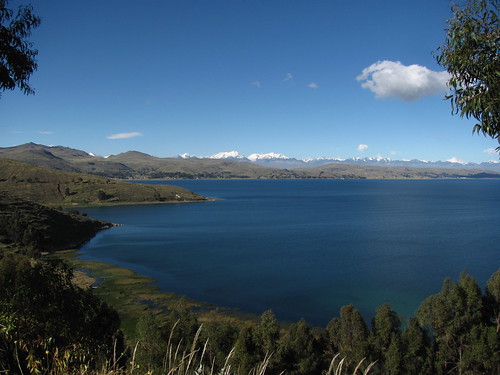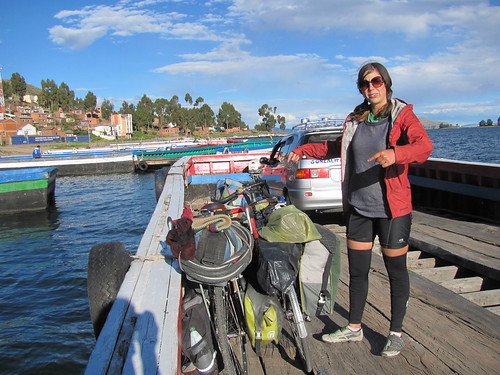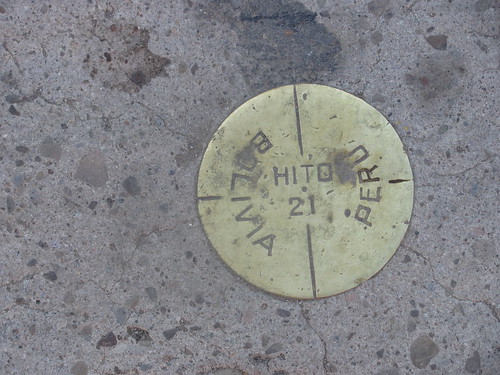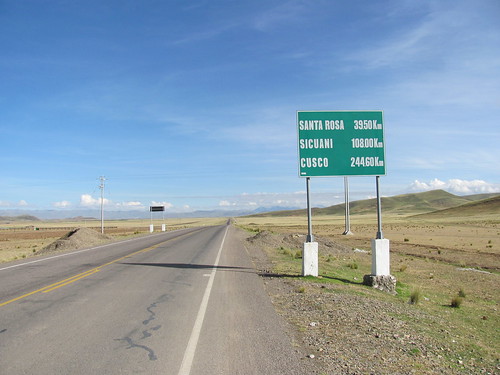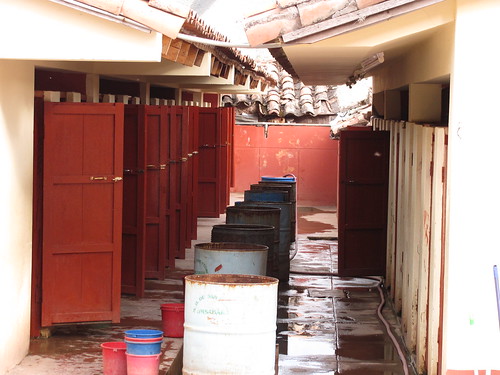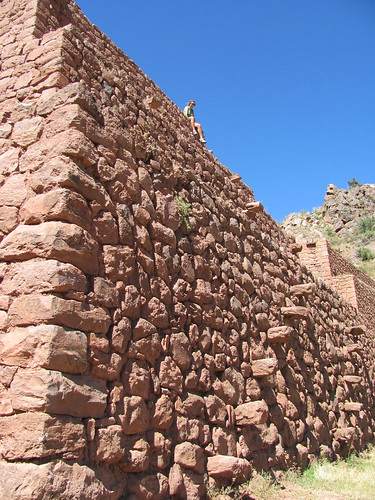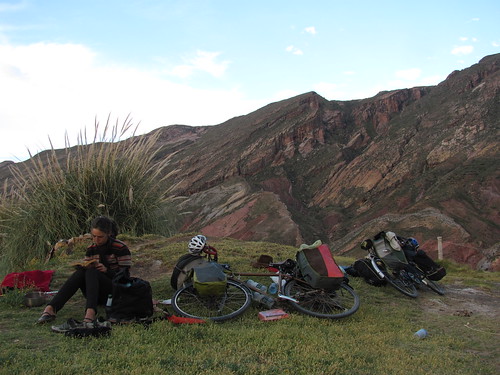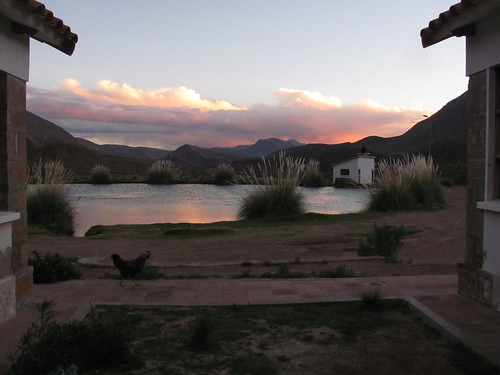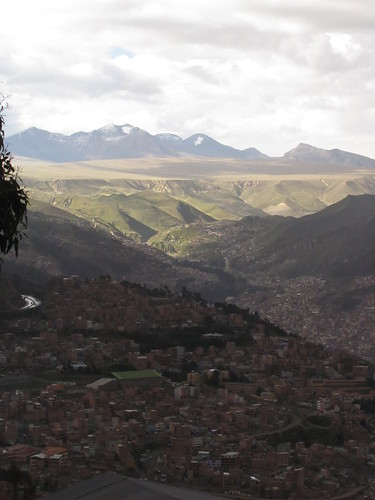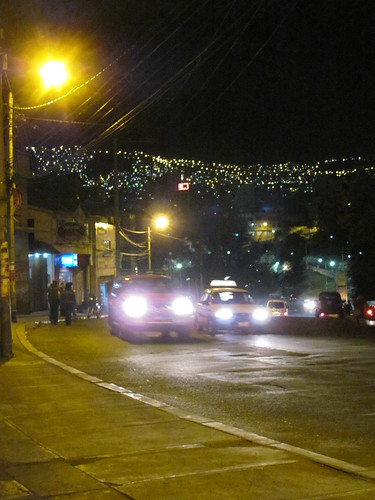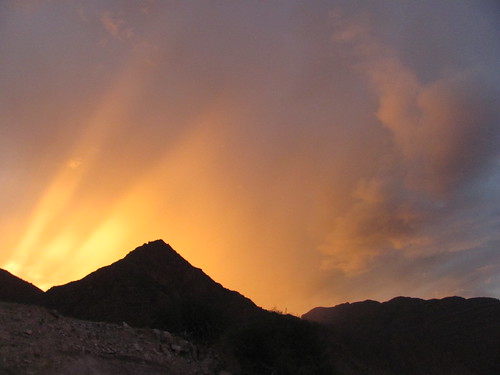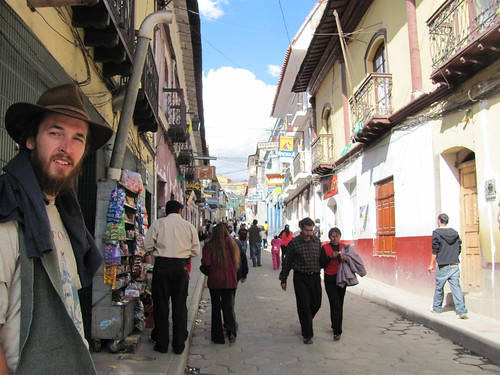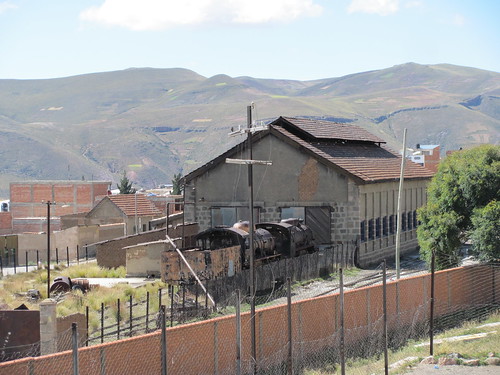The next day was a no go as well. Chris was feeling better but by the time we were feeling good enough to leave town, it was already the afternoon. We tried to go back and help at the cafe but there wasn´t much to do. Cristian closed early and we all went to Luisa´s for ¨Grand Comida¨ (dinner). This turned out to be Courtney and Chris cooking while the rest of the party sat by the warm fireplace with glasses of wine and beer. But the dinner was lovely and a great goodbye.
Our REAL farewell breakfast was at the cafe in the morning. A blast from the past: peanutbutter. Dorothy, also a cyclist, is convinced that all she needs for energy to bike all day long is a peanutbutter breakfast. So she shared with us to prove her point and to help us along with our day. We ate plenty, enjoying the taste that we hadn´t experienced since California. It turns out that she was right. We biked straight through the day and weren´t hungry until dinner. This may also have been the parasites that were filling our stomachs with gas. But we´ll never know. Our search for peanutbutter has yet to be realized in order to make a second test.
The original plan was to get up in time for a 5 am bus, but we had gotten to Cristian´s late the night before and we´re not very good at giving up sleep. Plus, by avoiding it, we got to eat breakfast with Dorothy. This was a good thing anyway because the straight up the canyon ride from the cafe to the bus stop took almost an hour. We thought to take the bus in order to avoid a ride straight up the canyon since Chris´s illness set us back 2 days. But every direction in La Paz is straight up.
The bus took us to Huarina, a town just on the edge of Lago Titicaca, about 60km from La Paz. The ride was beautiful and we were feeling better. The road took us along the coast of the lake (something compareable to the great lakes: complete with islands and at times you can´t see the other side for it´s vastness.) It was a great re-introduction to riding after several days off the bike. The first half was flat, and the scenery amazing. Afterwards we gently climbed up through the mountains weaving along the waterside like HWY 101 on the coast of California.
We descended back to the water´s edge at Taquina where we took the big wooden car ferry across the straight connecting the two massive portions of Lago Titicaca. That night we took advantage of the hospitality of the Naval Guard. They were very friendly but when we went to bed at 7:30 after it got dark the Guard was just beginning their evening drill which consisted of them playing hide-and-go-seek in the camping ground. ¨Stomp stomp stomp¨ with the big black boots, then ¨whisper whisper whisper¨ behind the trees and in the shadows. To make matters worse, it was Courtney´s turn to get sick. She was up and in the bathroom 3 times in the night getting strange looks from the Marines as she returned to the tent.
Things continued to get better, however. We were still able to ride the rest of the way to Copacabana the following day. The ride was just as gorgeous. We climbed up to a pass at 4300m but the roads this far north are much easier to manage. They are well planned. None of the ¨follow the valley until you hit the mountain then throw some switchbacks on there, ascend, descend down the mountain, and do it all again for the next valley mountain combo (of which there are many)¨ that was so present in southern Bolivia. Another interesting part of what made the trip so enjoyable was the evident lack of interest the dogs had in us. They noticed us go by and didn´t try to kill us. How pleasant.
We arrived in Copacabana early enough to get changed and then walk down the beach for the sunset. We enjoyed a beer on the waterfront at one of the many kioscos set up for just such a purpose. We ran into a friend from Tupiza who was on his way to the Isla del Sol. Then we did the touristy thing and got dinner at the Hosteling International Restaurant which was good but not great. Tasted like Argentina. The place we stayed at was incredibly friendly and right on the water front. They´ve painted their cabins beautifully and we got to play with the really tiny puppy that invited itself into our room.
 The boats made of reeds, floating in the port of Copacabana. Nearby there are entire islands made of the same reeds. Copacabana, Bolivia.
The boats made of reeds, floating in the port of Copacabana. Nearby there are entire islands made of the same reeds. Copacabana, Bolivia. The time had come to cross the border into Perú. After our experience in Bolivia, this border crossing was incredibly easy. On the way out of Bolivia we chatted for about 2 minutes with the authorities. On the way into Perú we exchanged no words. Stamp and go. The most immediate differences between Bolivia and Perú is the way they call you Gringo (with more gusto, sometimes coming from very small children learning to discriminate early) and the presence of millions of motorcycle and bicycle taxis. Later we would begin to notice that the level of friendliness went up considerably.
We were hoping to make it to Puno in 2 days. Our present pattern was to travel between 20 and 37 miles a day (20 on the unpaved roads 30 to 37 on the paved) Chris said ¨I keep waiting for the day that we go more than 30 miles since we used to go twice that¨ Well the land provided. Instead of struggling through dirt roads or climbing the altiplano (or both at the same time) like we´re used to, the road became flat and the wind wasn´t pushing us backwards with it´s normal force. We biked 40 miles, then 50 then 60.
The first push got us to Juli. The little Rome, they called it. It looked nothing like Rome. On our way we got our first taste of Peruvian Ruins. Stopping for lunch in a small town we were told to go to the Chullpas - tombs of the rich. They were under restoration but it was Saturday so all the workers were just taking off for the rest of the day. We still were able to get a brief explanation from the archeologist in charge. She was friendly and excited that we had stopped to visit. She even insisted on taking pictures with us.
But we were able to get a batch of antibiotics for the parasites that had been ailing us since our first day in Bolivia. Our first day out, we hoped we could rid our selves of the stomach pains for the last 20 days of the trip. The pharmacist told us that we couldn´t eat any of our normal foods except bread. She suggested we eat anis to restore the natural flora in our stomachs after the antibiotics killed them all. Luckily there was such a thing as anis bread in the town. It was delicious. We prepared a final meal to eat all of our fresh vegetables (only cooked vegetables for 3 days after the antibiotics) and other food we weren´t going to be able to eat and started the new routine in the morning.
We made it all the way to Puno the next day. The ride was beautiful and fairly flat. Max, the local host for all the bicyclists that come through Puno, biked to the edge of town to show us around. Took us to a hostel that gives discounts for cyclists and then met us for ¨dinner¨ which really meant taking us to his work where he sat with us a bit, worked a bit, and we ate pizza and tried the famous Pisco Sour, the national drink of Perú. It got late and we got tired, but we were in bed by 9:30, even after being accosted by a group of Argentine motorcyclists staying in the rooms next door. They were friendly and energetic, sharing mate and showing a ¨cyclists affinity¨ towards us.
In the night Courtney threw up the pisco sour but felt fine in the morning. We cooked vegetables in the hostel´s pressure cooker and scoured the town for peanut butter. They told us to try the pharmacy, so we bought peanuts and left. On the way out we met Mill, a touring bicyclist from Eugene, Oregon, riding a Bike Friday folding bike, trailing it´s rolling case behind him. A brilliant idea, making it easy to put the bike on the bus. He did mention that the frame broke and had to be replaced though.
After a good chat we headed north to Juliaca. The day was short since we were so late leaving Puno but the ride was completely flat and beautiful. Since we skipped riding in the altiplano of Bolivia, we were happy to have an easy ride for our last few days of the tour. Juliaca was discribed as a pit by Mill but it wasn´t too bad. It sports the highest theft rate in the country, being the main train hub of this area (connecting Arequipa to Puno and Cusco). We were lucky to not get robbed and stayed at an alojamiento for about $4 US which could best be described as ¨like a prison without showers.¨ But we slept well and were able to cook dinner on the hostel floor.
We liked Juliaca. The best part was probably the morning traffic. Not only was it traffic, something we hadn´t seen in a very long time, but it was bicycle taxi traffic. A street filled to the brim with bicycle and motorcycle taxis all fighting to get past the occasional delivery truck that was blocking the way. This is a picture directly taken from the ideal San Francisco Market Street Scene described the ¨Golden Wheel Award¨ keynote address in 2009. Acheived with ease here in Perú.
 Morning Traffic. This was taken after the taxis had thinned considerably, but it was still impressionante. Juliaca, Perú,
Morning Traffic. This was taken after the taxis had thinned considerably, but it was still impressionante. Juliaca, Perú,After Juliaca we biked north to Ayaviri, a small and crowded town with a huge market by the plaza. The roads were not great. Flat but full of holes. ¨Hueco¨ they called it. The first half of the day went by smoothly but then the nice pavement moved off to the right and we continued straight north. It was fine. Better than ripio (dirt roads). We still made it about 100km (60miles) for the day. On our way to Ayaviri we stopped for lunch and were joined by a flock of sheep and several cows. Shortly after a woman came over to chat with us and told us all about how she had 7 sons and they were all doctors. How did this sheep herder put 7 sons through medical school? We didn´t find out.
When we left in the morning we passed the first kilometer sign that we´d seen in Perú. It revealed, not only kilometers estimated to the hundreth (usually they´re rounded to the nearest 5km), but also that we could, in fact, bike to Cusco in the time that we had. We had been assuming that we would have to eventually take a bus the last portion of the ride. By biking the distances that we had been we could actually even take a day off at Aguas Calientes, the hotsprings just south of Sicuani.
Although we had been going rather far every day, we were a little wary of the 4300m pass that we were going to have to go up and over before the day was through. Our reward was going to be 10km of down hill and then a hotspring. Perú gets brownie points for the way they handled the climb. For the first 50km we rose about 100m, after that we went up at a somewhat steep angle (slowing us down but not to 5kph, more like 10 or 15kph. Not making us feel like dying) for 2 hours and then we were at the top. Magical. No walking the bike, no switchbacks, no sudden dirt road thrown into the side of a mountain. We were happy.
 The mountain pass. The mountain behind us is full of gold but the Peruvians like it just the way it is. La Raya, Perú.
The mountain pass. The mountain behind us is full of gold but the Peruvians like it just the way it is. La Raya, Perú.For our reward, some truckers who had stopped at Aguas Calientes as well, showed us the natural hot pool outside the hotspring resort and we camped right next to it. It was warm and very nice. We got to see the sun set from the water and then woke up at 5 am to climb back in and watch the sun rise. ¨Es la vida¨ we were told by an envious truck driver in the morning who didn´t have time to bathe, just to rinse off. We were joined by another truck driver later in the morning. Apparently this is the place to stop and get refreshed on the circuit from Cusco to Arequipa.
We decided not to go into the resort and get mudbaths and went, instead, to Sicuani for lunch and then biked a little further to Tinta. On our day off we still managed to go 66km. En route to Tinta, we stopped in San Pedro for another hotspring experience. ¨We´re only camping at hotsprings, from now on!¨ we decided. But San Pedro didn´t have a hotspring. It had ¨medicinal water,¨ which usually does mean a hot sulfury bath. In this case it was a cleansing yard. Water filters up past a volcano, collecting a host of minerals, comes out a fountain, and hundreds of people come on the weekends to drink around 20 glasses and spend the day lying down and using the toilet. It cleans the stomach, intestines, organs, etc. We came late and could only drink 4 glasses; the first 4 glasses of unfiltered water we´d had since Argentina. We think we got some medicinal benefits out of it, without expunging our whole digestive systems.
As we left we were told to visit Raqchi. It was the ¨Inca Residencial,¨ a standing wall that once held up the largest roof in the Incan Empire. It is surrounded by hundreds of stone huts, separated by small walkways, flanked by fields. It was worth the visit. The gate keeper even gave us a discount. Our second set of Inca ruins. We were a little more impressed with the first, the tombs that we happened to stumble upon a few days earlier, but part of that might have been the rapidly setting sun and our lack of place to sleep that was taking away from the experience.
Luckily Tinta was just around the corner. We rolled into the plaza and got to stay at a hostel. A little too expensive for the lack of services and the Señora´s ability to play dumb so that she didn´t have to answer questions. Still only about $5 US.
With only 2 days left until we were supposed to arrive in Pisac, we had to push to make it to and past Urcos the following day. We were unsure about the distance to Pisac on the unpaved road that cuts Cusco out of the route. We wanted to make it most of the way to the turn off just in case the last day would be difficult and long. Pisac is in the Sacred Valley, which would mean climbing up and over the large mountain range separating Cusco from the Valley. Unpaved usually means unplanned as well, and therefore more difficult (not following the easiest, but maybe the most direct route). We slept in Andahuaylillas after biking close to 100km. In the evening we tried to see what we were told was the only ¨Cistine Chapel¨ in America but it was closed. In the morning we didn´t bother and ate a huge breakfast instead (a celebration for our last day of bike tour).
After being told by every person we asked that the road was flat and then biking up and over a pass first thing in the morning, we were not optimistic. At the top of the pass, however, was an Incan and Huari Aquaduct which was enormous. One can climb to the top, following the classic Incan steps that jut out of the sides of the walls of their structures. While we were viewing the aquaduct, a Peruvian and Australian couple told us that the pass we had just crossed brought us into the Sacred Valley. We made it!
As it turns out, the unpaved road that was going to go up and over the mountains, was paved and all down hill. The scenery was indeed sacred, following the big Urubamba river through a narrow valley until it opened up into fields of deep red amaranth. We stopped just around the corner from Pisac for lunch and then biked into town to meet up with Robin, Courtney´s sister, and Laurie, Courtney´s dad.
Share|
